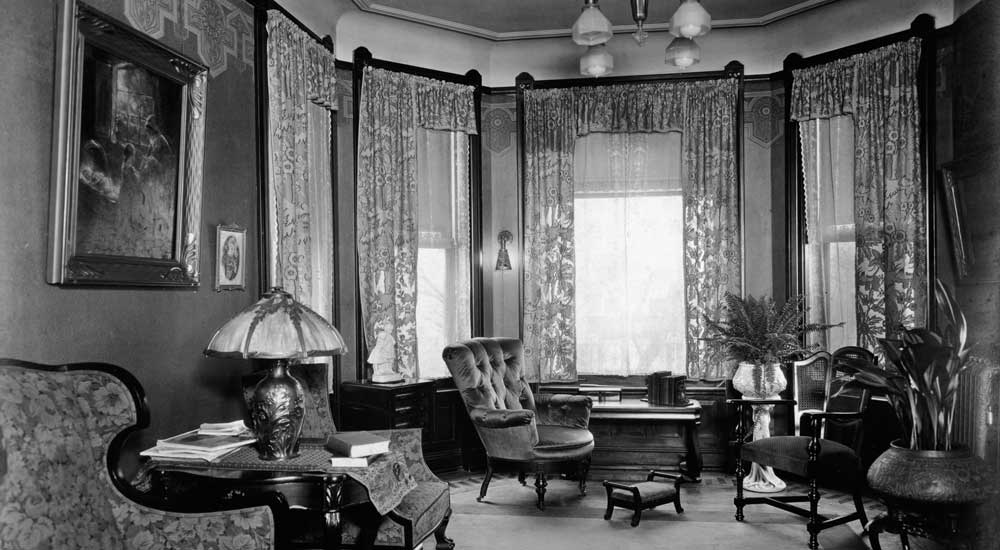Slideshow Album 7 showing 10 images and descriptions which accompany “Introducing the Tonnesen Models Part 1” has been posted.
Introducing the Tonnesen Models – Part 1
“Then destiny struck in Chicago; a photographer named Beatrice Tonnesen used pictures of live girls in ads for the first time…By the end of World War I, the rush to put women in ads was on.”
-Time Magazine
September 19, 1949
P. 89
Beatrice Tonnesen, assisted by her sister/business manager Clara, revolutionized the world of print advertising. Not only is Tonnesen reported to have pioneered the use of live models in advertising around the turn of the last century, she reportedly also operated as a modeling agency, thereby controlling access to some of the era's most photographed faces…and all of that was in addition to her prolific contributions to the world of calendar art.
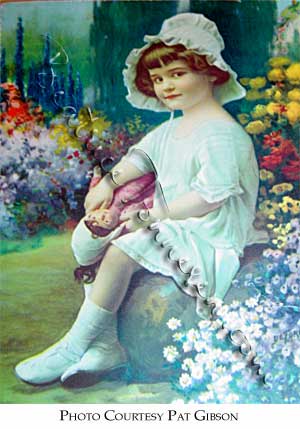 Given her reported work as a modeling agent, it’s quite possible that when we come across the likeness of a Tonnesen model in a work produced by another studio, it is because Tonnesen or someone employed by her, assigned the model to that project. Photographers aren't often identified, either in print ads or in calendar art, but, so far, I have found Tonnesen models in works attributed to four other photography studios of the era: the Keedy, Riel, Stadler and Alsop Studios.
Given her reported work as a modeling agent, it’s quite possible that when we come across the likeness of a Tonnesen model in a work produced by another studio, it is because Tonnesen or someone employed by her, assigned the model to that project. Photographers aren't often identified, either in print ads or in calendar art, but, so far, I have found Tonnesen models in works attributed to four other photography studios of the era: the Keedy, Riel, Stadler and Alsop Studios.
For that reason, when it comes to determining whether or not an image originated with Tonnesen, the presence of a Tonnesen model alone is not sufficient. (See “Identifying Tonnesen's Work…” for other identifiers.) But it's a very good start, and for that reason, I set about the work of identifying her models a couple of years ago.
This series of articles displays images of Tonnesen’s more commonly featured models. (We’ll display images from some of her print ads in a future post.) My primary objective is to show these models from various angles in a variety of settings to help make them more recognizable for the purpose of identifying Tonnesen's works. But I also am hopeful that someone out there will recognize an ancestor's face or name, or, even more exciting, him or herself. Tonnesen produced calendar art until around 1930, so some of the child models might very well be living. Everytime we identify a model or find a model's family, we have the potential to learn something new. The models seem to have shared their memories with their families, and passed down souvenirs of their careers which are rich in information about Tonnesen's work.
In this first installment, we'll take a look at the work of child models Virginia Waller and Janie Burkhardt (or Berkhauer) and Jean Blackwell, who often portrayed the mother. The images accompanying this article appear in Slideshow Album 7 along with explanatory captions. I have no biographical information on Janie or Jean. But, I've found that it adds meaning to the artwork when we recognize and reflect on the fact that our treasured prints feature real people who lived real lives. With that in mind, Virginia's story appears below.
Virginia Waller Wicks
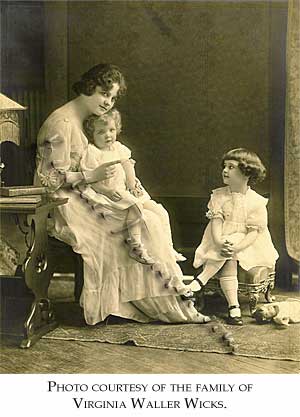 Born March 1, 1913, Virginia Waller (shown here with Jean Blackwell and Janie Burkhhardt/Berkhauer) began modeling when she was only three years old. Her son, Ken, remembers Virginia telling him that she and her mother were shopping in a Chicago store when Beatrice Tonnesen approached and asked if Viginia might be allowed to model for her photos. By that time, Tonnesen had a booming business providing images for print advertising as well as calendar art. Virginia became a familiar figure in the so-called “Cult of Motherhood” genre that was gaining popularity in illustration art in the late teens and 20's. Her short bobbed hair, dainty dresses and patent leather Mary Janes were emblematic of children's fashion of the era. Indeed, in my experience, Virginia seems to have been the most photographed of Tonnesen's child models.
Born March 1, 1913, Virginia Waller (shown here with Jean Blackwell and Janie Burkhhardt/Berkhauer) began modeling when she was only three years old. Her son, Ken, remembers Virginia telling him that she and her mother were shopping in a Chicago store when Beatrice Tonnesen approached and asked if Viginia might be allowed to model for her photos. By that time, Tonnesen had a booming business providing images for print advertising as well as calendar art. Virginia became a familiar figure in the so-called “Cult of Motherhood” genre that was gaining popularity in illustration art in the late teens and 20's. Her short bobbed hair, dainty dresses and patent leather Mary Janes were emblematic of children's fashion of the era. Indeed, in my experience, Virginia seems to have been the most photographed of Tonnesen's child models.
Virginia modeled regularly for four years, roughly 1916-1919, but she evidently returned periodically over the years for “guest appearances.” Her family has a few photos of her that seem to have been taken in her teenage years.
Virginia went on to graduate high school and work as a billing supervisor for fourteen years before becoming the wife of Willard Wicks and the mother of Kenneth and Sharon. She fondly remembered her work with Beatrice Tonnesen, and was proud of the beautiful photographs in which she had appeared. A few months after Virginia's death in October, 2006, the family held a memorial service in New Mexico where she and her husband had retired. The service featured displays of photos and prints showing the young Virginia happily portraying the model child that she was.
Coming soon:
Part 2: Images of William Redmond (1908-1992), the child model who later became Speaker of the Illinois House of Representatives; his recollections of the thriving photographic art studio scene of his youth. Images of Betty Crowe (1910 – ); what she has to say about working with Beatrice Tonnesen, Virginia Waller and William Redmond.
Part 3: Images of other models frequently featured in Tonnesen's works with approximate timelines.
Part 4: Turn of the century models – those found in the black and white newspaper Sunday supplements and those elaborately framed Victorian parlor scenes.
All Content Copyright 2008 Lois Emerson
Beatrice Tonnesen Introduced New Trend In 1890 Advertising
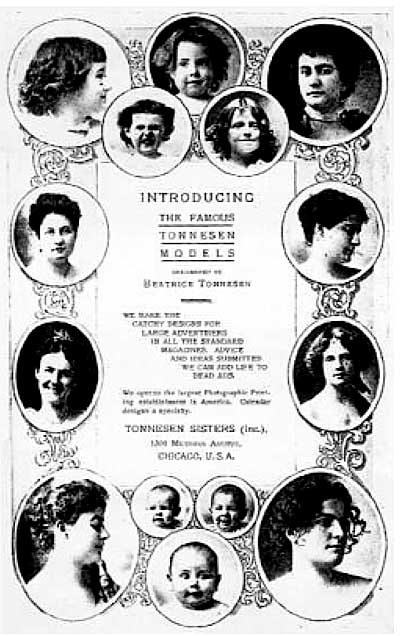 Following is a reprint of an article in the Oshkosh Daily Northwestern from Wednesday, September 29, 1954. The image of The Famous Tonnesen Models is from an advertisement in the 1903 issue of Profitable Advertising. Admittedly it is of poor quality. I am looking for an original to properly reproduce for a Zoomify image.
Following is a reprint of an article in the Oshkosh Daily Northwestern from Wednesday, September 29, 1954. The image of The Famous Tonnesen Models is from an advertisement in the 1903 issue of Profitable Advertising. Admittedly it is of poor quality. I am looking for an original to properly reproduce for a Zoomify image.
Beatrice Tonnesen Introduced New Trend In 1890 Advertising
Photographer, Oshkosh-Trained, Wins World Renown
Author Turner says that in the pages of “Advertising Experience”, published in Chicago in 1899, “There were captivating advertisements by Beatrice Tonnesen of Chicago who pioneered the use of live models in advertising. She offered for photographic purpose an unlimited range of beautiful and fascinating women, handsome men and pretty, bewitching children.' ” The author points out that one of her fascinating women was shown, dressed only in a skin-clinging union suit, tugging at the grips of an exerciser. But, he says, “More conventional were Beatrice Tonnesen’s pictures of dining cars on the Chicago, Burlington and Quincy Railroad, in which all the tables were occupied by Tonnesen models, looking no less poised and well-bred than the young women who are photographed in stratocruisers today.”
Portable Combination Sewing Table and Cabinet – Patent 1,547,846
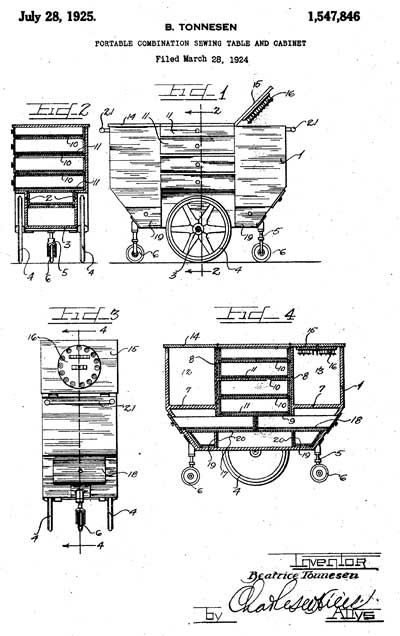
To all whom it may concern;
Be it known that I, Beatrice Tonnesen (full name), a citizen of the United States and a resident of the city of Chicago, in the county of Cook and State of Illinois, have invented certain new and useful Improvements in a Portable Combination Sewing Table and Cabinet; and I hereby declare that the following is a full, clear, and exact description of the same, reference being had to the accompanying drawings, and to the numerals of reference marked thereon, which form a part of this specification.This invention relates to a portable combination sewing table and cabinet, and it is an object of this invention to provide such a structure which can be readily rolled or moved to different parts of a room as occasion requires. It is a further object of this invention to provide such a structure with drawers and article holding compartments.
With these and other objects in view which will become more apparent in the following description and disclosures the invention comprises the novel structure and combinations hereinafter described and more particularly pointed out and defined in the appended claim.
Get the full text of the legal description in PDF format here.
Popular Boy and Dog Image Found in Tonnesen Archive
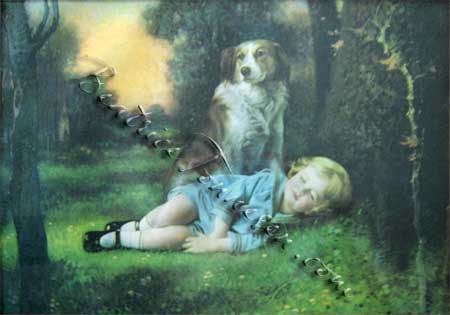 (Editor’s Note: 9/20/12: The publisher of a calendar featuring this print identified the artist as Alan Austin Pope, seeming to rule out the possibility that the A. Pope who painted from Tonnesen’s photos was Alexander pope, painter of dogs and wildlife.)
(Editor’s Note: 9/20/12: The publisher of a calendar featuring this print identified the artist as Alan Austin Pope, seeming to rule out the possibility that the A. Pope who painted from Tonnesen’s photos was Alexander pope, painter of dogs and wildlife.)
(Editor’s Note 2/13/08: Update- This print has been found with the signature “A. Pope.” Alexander Pope (1849-1924) was a well-known painter who specialized in dogs and wildlife. I am attempting to verify the signature. I will be posting another signed A. Pope print, which also started as a photo by Tonnesen, shortly.)
(Editor’s Note 5/26/2010: Update- A site visitor, Pat Johnson whose initial message appears at the bottom of this post, has kindly provided us with a copy of a letter written by Beatrice Tonnesen in 1954. Pat’s mother had written to Tonnesen regarding this print, which she owned. In her response, Tonnesen revealed that the child who posed for the photo was actually a girl! Tonnesen wrote: “…the child was a beautiful little girl…That child was not even asleep! Just posed for me completely relaxed. Quite remarkable for one so young.”)
As a collector of early twentieth century illustration art, I've wondered for years about the unsigned, untitled “mystery” print shown at top right. The sleeping boy and his trusty guard dog were popular subjects of a number of artists of the era. This little boy in his Edwardian outfit always looked to me like the child in RA Fox's “The Children's Hour,” done under his DeForest pseudonym. So I've always thought maybe this one, too, was by Fox.
And maybe Fox did paint the woodsy sunset and the flowered lawn, and the colorful details of the boy and dog. I don't know. (Although the flowers in the grass do look especially Foxy to me!) But the boy and dog definitely originated as a photo by Beatrice Tonnesen. Her original photo, shown bottom right, can be found in the Tonnesen Archive of the Oshkosh Public Museum. (Note the photo was taken inside with a crude prop under the boy's head, as though it was planned that another background would be added later.) Fox is reported to have shared Tonnesen's studio for a time during the ‘20's, and is known to have painted on occasion from Tonnesen's photos.
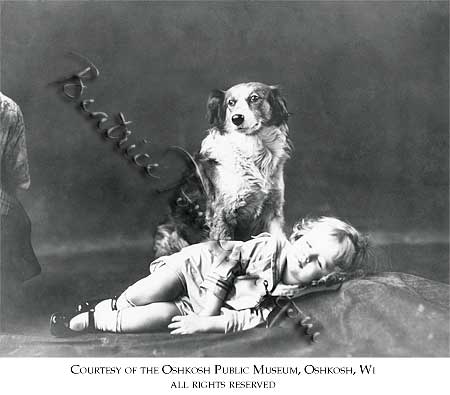 Tonnesen herself was an accomplished painter, and it is possible that she was both the photographer and the artist. My theory, however, is that when she alone was responsible for both the photography and the painting of a work, she signed it. More often, it appears, she sold her photographs to artists and publishers for their use, to embellish as they desired, without crediting the photographer. So I think this beautiful print was finished by some other artist – maybe R Atkinson Fox or, possibly, a talented staff artist employed by the publisher. What do you think? Regardless of the artist's identity, I'm happy that we can now credit Tonnesen with the creation of the appealing photographic image that is central to the work.
Tonnesen herself was an accomplished painter, and it is possible that she was both the photographer and the artist. My theory, however, is that when she alone was responsible for both the photography and the painting of a work, she signed it. More often, it appears, she sold her photographs to artists and publishers for their use, to embellish as they desired, without crediting the photographer. So I think this beautiful print was finished by some other artist – maybe R Atkinson Fox or, possibly, a talented staff artist employed by the publisher. What do you think? Regardless of the artist's identity, I'm happy that we can now credit Tonnesen with the creation of the appealing photographic image that is central to the work.
(For more information on R Atkinson Fox and other early twentieth century illustrators, visit the RA Fox Society.)
All Content Copyright 2007 Lois Emerson
Other Side of a Cook Ely Photograph
This is the Zoomified reverse side to a Cook Ely photograph. Cook Ely trained Beatrice Tonnesen and some few years thereafter retired and sold his studio equipment to Beatrice.
The image is interesting for the photographic society, the photographic award, the technology mentioned, the date, the address, the fancy type font, and the edge design.
This particular image is of the backside of Tonnes Tonnesen’s image, Beatrice’s father. It is representative of one of the two images of young Beatrice in Slideshow Album 3, both of which were taken by Cook Ely. I will post the flip side of the other image later.
